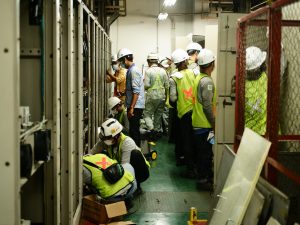As industries evolve, so too must safety practices. Gone are the days when helmets and gloves alone could address the complex risks of industrial environments. Today, the future of workplace safety lies in technology-driven solutions—with Smart PPE (Personal Protective Equipment) and real-time monitoring systems leading the way. This article explores the innovations transforming industrial safety and what companies must do to stay ahead.
What is Smart PPE?
Smart PPE refers to wearable gear embedded with sensors, connectivity features, or AI-powered tools that collect data, monitor worker conditions, and issue alerts in real-time. These innovations go beyond traditional protection—they help predict, prevent, and respond to hazards more effectively.
Why Innovation in Safety is Critical
- Increasing complexity of job sites
- Remote and extreme environments (e.g., offshore rigs, mining tunnels)
- Rise in regulatory demands
- Need for real-time data for decision-making
- Worker expectations for safer, smarter equipment
Traditional PPE does not provide feedback, real-time communication, or incident data—technological upgrades fill this critical gap.
Key Smart PPE and Safety Technologies to Watch
1. Wearables with Real-Time Monitoring
Smart helmets, vests, and wristbands are now equipped with:
- Vital signs monitoring (heart rate, body temp)
- Fatigue and motion sensors
- GPS tracking for lone worker safety
- Fall detection and impact alerts
Benefit: Alerts supervisors immediately in case of a medical emergency or accident.
2. Internet of Things (IoT) Integration
IoT connects smart PPE to centralized safety dashboards. Supervisors can:
- Monitor multiple workers across a site
- Receive automated hazard alerts
- Access data for compliance reporting
- Predict maintenance needs for equipment
Example: A gas sensor in a worker’s mask sends alerts if toxic fumes exceed safe limits.
3. AI-Powered Safety Analytics
Artificial Intelligence (AI) helps process safety data to identify patterns:
- High-risk zones on a site
- Common unsafe behaviors
- Time-based fatigue trends
- Predictive analytics for incident prevention
Benefit: Enables proactive safety planning and targeted training.
4. Augmented Reality (AR) Helmets and Visors
AR-equipped helmets overlay digital instructions or hazard warnings onto the worker’s field of vision. Ideal for:
- Complex repairs
- Hazard navigation in low-visibility zones
- Real-time communication with off-site experts
Benefit: Enhances accuracy and reduces error rates on technical tasks.
5. Smart Fire-Resistant and Impact Gear
Innovative materials now combine traditional FR and impact protection with:
- Built-in thermal sensors
- Automated distress signals
- Pressure alerts on gloves or boots
Benefit: More durable, multi-functional, and life-saving than older models.
Industries Leading the Charge in Smart Safety
- Oil & Gas: Remote monitoring, gas leak sensors, and lone-worker alerts
- Construction: Smart vests and AI-powered CCTV for behavior tracking
- Mining: Real-time air quality detection and underground geolocation
- Logistics/Warehousing: AR glasses and exoskeletons for lifting and efficiency
Benefits of Embracing Safety Innovation
Fewer Workplace Incidents
Proactive detection means reduced injuries and fatalities.
- Improved Worker Confidence & Morale: Employees feel safer and more valued.
- Faster Emergency Response: Automated alerts can cut rescue time drastically.
- Better Compliance & Record-Keeping: Digital records help with audits, inspections, and legal protections.
- Cost Savings: Fewer accidents mean fewer claims, fines, and project delays.
Challenges to Adoption
- Initial Investment Costs
But ROI is high with reduced injuries and downtime. - Worker Training Needs
Any new tech requires proper orientation. - Data Privacy Concerns
Must ensure collected data is secure and used ethically.
Preparing for the Future
To stay competitive and compliant, businesses should:
- Partner with smart PPE suppliers with proven track records
- Audit current safety systems to identify upgrade needs
- Invest in training and change management
- Pilot small-scale smart PPE programs before full deployment
- Align innovation with industry regulations and standards
Conclusion
Industrial safety is no longer reactive—it’s predictive, connected, and intelligent. Smart PPE and safety tech represent the next frontier in protecting workers, enhancing productivity, and ensuring long-term operational resilience. For companies in high-risk industries, adopting innovation is no longer optional—it’s essential.
Lead the Safety Revolution with SOC Energy Services Ltd
We supply forward-thinking PPE solutions and safety services tailored for Nigeria’s evolving industries. Stay ahead of the curve. Contact us today to future-proof your workforce.





